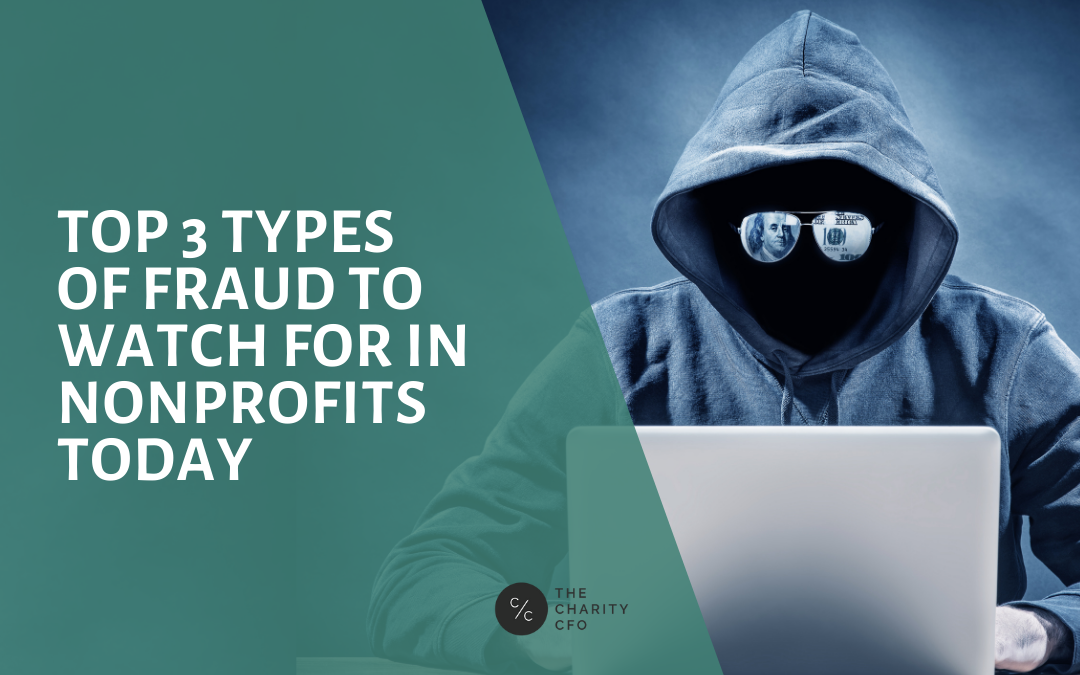Nonprofit fraud makes for great headlines— like the Minnesota nonprofit Feeding Our Future accused this year of squandering $48 million of federal funding on luxurious trips, fancy mansions, and other personal costs.
Fraud losses in the charitable industry destroy an organization’s reputation, future financing opportunities, and capacity to carry out its mission. According to The New York Times, the value of nonprofit fraud is approximately $40-50 Billion each year. Nonprofit fraud impacts nearly one in five nonprofit organizations, according to some estimates.
While most nonprofits work tirelessly to make a difference in the community with a shoestring budget and tiny workforce, these highly-publicized cases of nonprofit fraud erode public trust and cause people to hesitate to give their money to worthy organizations.
So let’s take a look at what nonprofit fraud looks like so you can know what to look for and help keep your organization out of trouble.
The Case of the Missing $48 Million
On January 20, 2022, the FBI raided the offices of Feeding Our Future in Minneapolis and the home of its founder. Feeding Our Future received funding from the United States Department of Agriculture through the Child and Adult Care Food Program and the Summer Food Service Program—money intended to provide meals to children. But investigators allege the organization used most of that money to fund personal costs, like luxury cars and lakefront homes.
How was this fraud uncovered?
The education first department reported Inconsistencies to the USDA in 2020. They lacked evidence to explain a significant spike in the number of community locations Feeding Our Future claimed to support.
And in early 2021, the department labeled Feeding Our Future “seriously defective” due to incomplete financial audits and lapsed IRS nonprofit registration. As a result, they suspended all payments to the organization.
Now, the BIG question— how did this happen?
Officials from the Minnesota Department of Education told FBI agents that the USDA’s loosening of restrictions during the COVID-19 outbreak rendered these programs more prone to exploitation.
The USDA relaxed the rules for those who can participate in the programs, allowing for-profit restaurants to join and allowing meals to be packaged and consumed off-site.
Moreover, the USDA dropped in-person surveillance restrictions due to the pandemic, making it easier to cover up potential deceit.
The Feeding our Future case is unusual in the scale of the alleged fraud, but assuming criminal activity took place, it must have required collusion between multiple parties. Proper accountability, oversight, and separation of duties in nonprofits would prevent grift on this scale from taking place.
Let’s look at the 3 types of fraud impacting nonprofits most frequently today.
3 Common Types of Fraud in Non-profits
Fraud committed by nonprofits organizations frequently follows a similar pattern. The three typical fraud schemes include:
#1: Corruption
Corruption is the improper use of influence in a business transaction to obtain benefits for oneself or others at the expense of one’s employer. Corruption is involved in 43% of occupational fraud cases across all industries.
According to Merriam-Webster, corruption is “dishonest or illegal behavior especially, by powerful people.” In this case, nonprofit corruption generally involves the senior leadership of a nonprofit organization.
Corruption can include:
-
- Bribery occurs when cash or another asset is taken or offered in exchange for assistance in the scam. This often takes the form of invoice fraud and vendor kickbacks or bid-rigging schemes.
- Extortion is obtaining an asset via the use of force or threat of force.
- Conflict of Interest corruption may involve purchasing schemes with related parties (i.e., paying too much for services or goods and not getting competitive bidding beforehand), fictitious vendor schemes, or billing schemes.
The most common type of corruption found was conflict of interest, which resulted in a median loss of $200,000 per event. Bribes were the second most common form of corruption, accounting for one-third of individuals reporting fraud. Cases involving improper gifts resulted in the highest corruption losses, with a median cost of around $3 million per instance.
How Can You Avoid Corruption In Your Nonprofit?
✔️ Board Oversight – The board needs to understand where the funds are coming from and our significant expenses. And then ask the right questions to understand the organization’s financial position.
✔️ Annual conflict of interest statement – All senior leadership and board members should fill this out and must disclose any related party.
✔️ Annual independent financial audit – An auditor can find numbers that don’t make sense and may help head off schemes before losses are too large. It’s also an excellent deterrent to would-be offenders.
✔️ Segregation of duties – Ensure that no senior leadership member is driving critical processes in the organization. Have a whistleblower policy, and individuals within the organization share the responsibility.
Check Tampering
Check tampering is essentially forging or manipulating checks written. Check tampering is one way of “asset misappropriation,” which is the theft of tangible assets— in this case, stealing money.
Check tampering usually happens when:
- Checks are altered after they are signed by the appropriate person (changed amounts, vendor name, mailing address, etc.)
- An unauthorized person forges checks.
- Unauthorized people make transfers or bill payments that are not approved. This can also include inappropriate charges or cash advances on credit cards.
Other examples of asset misappropriation include theft of cash on hand, theft of cash receipts (posting payments received in the accounting system without depositing them), expense reimbursement fraud, and vendor payment schemes.
How Can You Avoid Check Tempering?
✔️ Create a check-signing policy that ensures multiple layers of review
✔️ Implement segregation of duties so that the person who prepares checks is not the same person who initiates the payment request
✔️ Use a 3rd party check paying system, like Bill.com, to ensure physical checks cannot be tampered with
✔️ Strictly limit access to check stock to authorized employees
✔️ Review checks carefully to ensure the vendor’s name on the invoice matches the vendor’s name on the check
✔️ Review bank statements carefully to ensure that all checks cleared are to familiar vendors.
✔️ Review online bank and credit card activity to be sure electronic withdrawals and charges are appropriate and reasonable
Billing Fraud
Billing fraud typically happens when services are paid for by funders but not delivered.
Billing fraud is so common because many medium to large-sized nonprofits have government contracts. And many government grants pay for services on a cost-per-unit basis rather than issuing a large one-time check.
Each month, a nonprofit must tally up the services rendered and bill funders based on the agreed-upon rate. If they simply say they’ve delivered more units of service than they did, they can secure extra funding. And it can be very hard to detect.
Several factors cause the incentive to inflate their billing numbers:
- Pressure from upper management on programmatic staff to increase impact and number of people served. By inflating billing numbers, it appears they had a more significant effect.
- Financial struggles. The organization will receive additional funds that they may feel they “need” to stay operational by billing more units.
- Dishonest staff. In some cases, a staff member is expected to deliver a specific number of services. By falling short, they may fear their job is at risk. The team may be motivated to exaggerate the volume of services and clients they are working with to stay in good standing with their supervisor.
- Pressure from funders. Funders make allocations to organizations with the understanding that all services included in the contract will be rendered. Organizations understand that failure to exhaust these contracts fully will result in reduced funding next year.
How Can You Avoid Billing Fraud?
✔️ Oversight and management. Regularly review the volume of clients and participation records (attendance records, case notes, client files), periodically to ensure that your participants are real and are receiving services.
✔️ Develop expectations. Understand the status of grants and funding throughout the year. Understand any trends or seasonality in the delivery of services (i.e., the school-based program ends in summer; therefore, we expect fewer services). Monitor fluctuations regularly to ensure you are on track.
✔️ PTO policies and cross-training. Ensure that there is cross-training and forced PTO for those that compile billing numbers. Having a rotation will ensure a consistent process is followed.
✔️ Have a relationship with your funders; if there are any discrepancies or instances of inadequate or inappropriate documentation, have an open-door policy.
✔️ Participate in a financial statement audit. Have your Statement of Financial Position and Statement of Activities reviewed by a professional auditor to identify suspicious numbers you may miss.
Solving Nonprofit Fraud Starts with Prevention
While it is critical to respond immediately to fraud, the best method is to avoid the scenario in the first place. It is impossible to expect a nonprofit organization’s governing body and leadership to eliminate the danger of fraud, but you can take practical actions to reduce it.
You can avoid putting your nonprofit’s hard-earned reputation at risk by creating an environment where ethical behavior is expected. And by creating robust internal controls a proactive fraud detection and response program.
And, of course, the cleaner and more accurate your accounting, the easier it will be to find numbers that don’t make sense. If you’d like help modernizing your accounting system and keeping a closer eye on what’s happening with your money, reach out to The Charity CFO for a free consultation.
We provide outsourced nonprofit bookkeeping and accounting services for over 150 US-based nonprofit 501(c)(3) charity organizations. Our team of financial experts include former nonprofit CFOs and auditors, so we can help you find and fix your biggest issues before the auditor comes knocking.
If accounting and bookkeeping are keeping you from accomplishing your mission, please reach out to see how we can help you!

Do You Struggle to Make Sense of Your Financial Statements?
Get our FREE GUIDE to nonprofit financial reports, featuring illustrations, annotations, and insights to help you better understand your organization's finances.
Get the free guide!





0 Comments